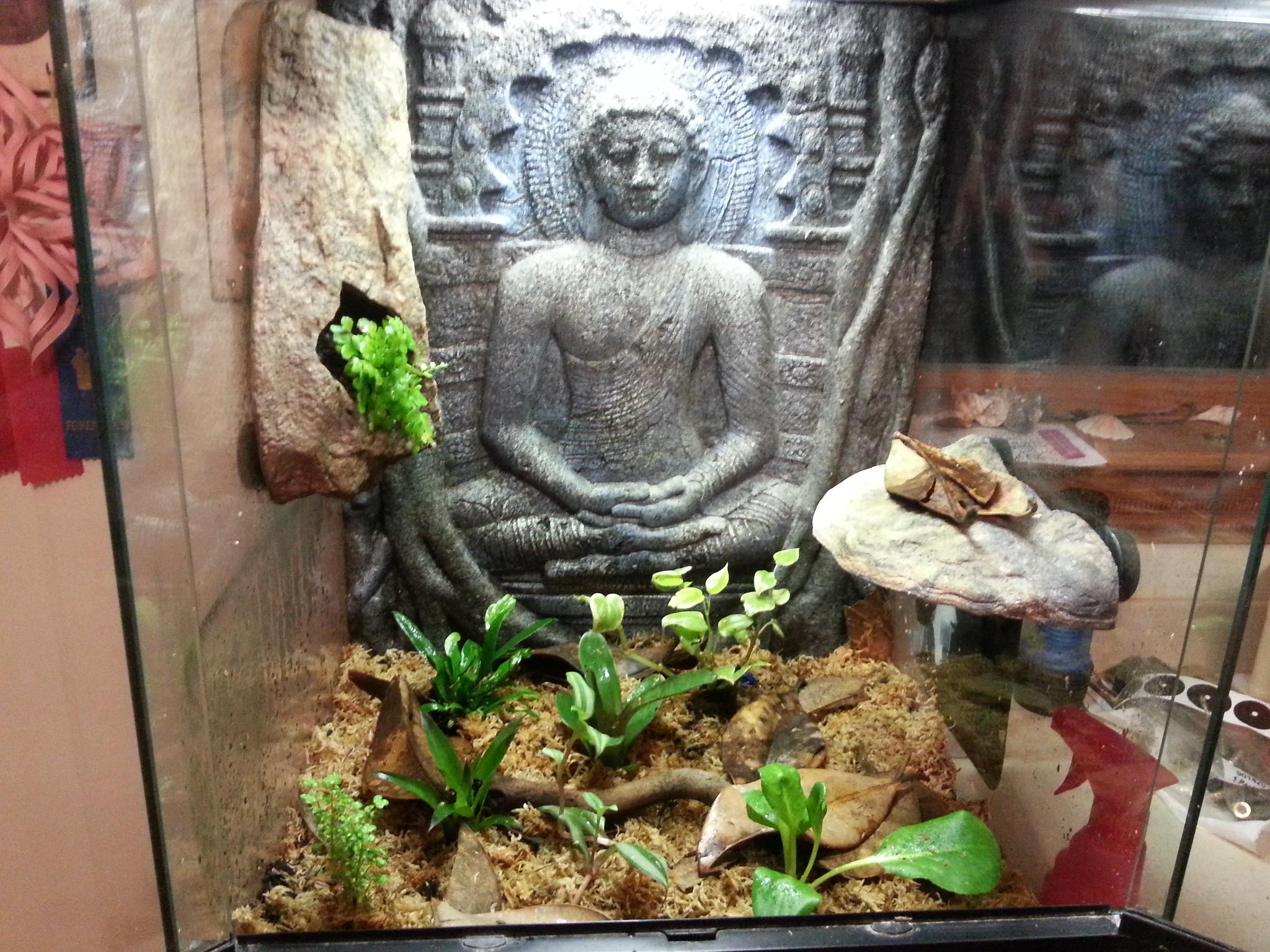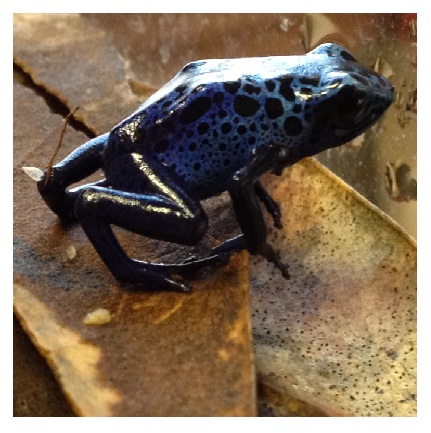Habitat

 three times a day next to the
enclosure. The plants vary in species but
contain ferns, bromeliads, and common vine plants.
The substrate is sphagnum moss, which retains
moisture and wicks water down to a dirt layer below,
which hydrates the roots of my plants and also
contains and anti-fungicide which keeps harmful
fungi from growing in my tank. Below the dirt
layer is a square of landscape fabric which
separates the dirt from the rock layer I have at the
bottom, which provides a layer for excess water to
sit so that it doesn't cause any flooding or molding
of my plants. As mentioned on the
Classification page, these frogs are commonly found
among the leaf litter in the tank, which I have also
provided for my synthetic natural environment. Perdita, my female frog, is usually found underneath
the leaves in the tank or in the rock structure
hanging from the left of the enclosure. Pongo,
my male frog, is a bit more adventurous and goes
where he pleases. He is pictured here, sitting
atop the leave litter on the raised perch which you
can see on the right side of the tank.
three times a day next to the
enclosure. The plants vary in species but
contain ferns, bromeliads, and common vine plants.
The substrate is sphagnum moss, which retains
moisture and wicks water down to a dirt layer below,
which hydrates the roots of my plants and also
contains and anti-fungicide which keeps harmful
fungi from growing in my tank. Below the dirt
layer is a square of landscape fabric which
separates the dirt from the rock layer I have at the
bottom, which provides a layer for excess water to
sit so that it doesn't cause any flooding or molding
of my plants. As mentioned on the
Classification page, these frogs are commonly found
among the leaf litter in the tank, which I have also
provided for my synthetic natural environment. Perdita, my female frog, is usually found underneath
the leaves in the tank or in the rock structure
hanging from the left of the enclosure. Pongo,
my male frog, is a bit more adventurous and goes
where he pleases. He is pictured here, sitting
atop the leave litter on the raised perch which you
can see on the right side of the tank.However...
On to a more scientific approach to the natural
habitat of this species, they are often referred to
as coming from a central range from Suriname.
Most of their distribution is in Suriname on the
"forest-islands" found within the Sipaliwini-savanna,
few frogs having been found and collected in the
forests along the western border of the savanna.
These frogs require areas with
high humidity and moderate to cooler temperatures.
They spend most of their time on the ground among
leaf litter, rarely going into pools of water.
While being
mostly terrestrial, these organisms,
when venturing to water, only tolerate fresh water
sources. Dendrobatid frogs are very
territorial and maintain a specific area of range
within which they discourage other frogs from
entering.
border of the savanna.
These frogs require areas with
high humidity and moderate to cooler temperatures.
They spend most of their time on the ground among
leaf litter, rarely going into pools of water.
While being
mostly terrestrial, these organisms,
when venturing to water, only tolerate fresh water
sources. Dendrobatid frogs are very
territorial and maintain a specific area of range
within which they discourage other frogs from
entering.
Hoodmoed, in 1969, conducted extensive studies of
Dendrobates azureus and found many unique
characteristics. Among some of the general
range details, as mentioned before, he noted that
the Dyeing dart frog was only found when there were
also boulders. While not water-based
amphibians, these frogs were usually captured within
twenty meters of the creeks that ran through the
various forest islands. This frog was also
captured within a range of 315 and 430 meters of
elevation above sea level.
The Dyeing dart frog lives among various animals
common to South America including the
jaguar and lives among various trees such as
Theobroma cacao and other such plants like
the
Stone-breaker. To learn what other
organisms inhabit Suriname and the areas the Dyeing
dart frog inhabit, visit the website for the
National Zoological Collection of Suriname.
More animals which interact and live among the
Dyeing dart frog will be mentioned on the
interactions page, later in this tour but feel free
to skip ahead.